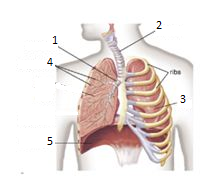7th Grade > Biology
RESPIRATION IN ORGANISMS MCQs
Total Questions : 96
| Page 3 of 10 pages
:
Definition: 1 Mark
Cause: 1 Mark
Recovery: 1 mark
A muscle cramp is a painful contraction or tightening of the muscles for a few seconds.
They happen when the cells in the muscle respire anaerobically. The glucose in the muscles is converted into lactic acid, and the lactic acid accumulation causes cramps.
Muscle cramps can be cured by massages orhot water bath because it improves blood circulation. Blood suppliesoxygen to the muscle cells. Oxygenspeeds up and completes the breakdown of lactic acid into carbon dioxide and water.
:
Differences: 1 Mark each
Human beings have well-defined organs to breathe. We breathe through our lungs.
Cockroaches have small openings called spiracles on the sides of its body. The air rushes through the spiracles and reaches tracheal tubes, then diffuses into the bodytissues and reachesevery cell.
Frog breathes through its skin under water. On land frog uses lungs to breathe. Earthworm also breathes through its skin.
:
Each point: 1 Mark
The process of breathing happens as follows:
1. We take in air through our nostrils. When we inhale, air passes through nostrils into the nasal cavity whichreaches the lungs through windpipes.
2. The chest cavity where the lungs are present is surrounded by ribs on thesides and diaphragm forms the base.
3. Breathing involves the movement of the diaphragm and the rib cage.
4.During inhalation, ribs move up and the diaphragm moves down to increase the chest cavity space. When the volume in the lungs increases, pressure decreases, which fill the lungswith air.
5. During exhalation, ribs move down and the diaphragm moves up to its former position. The lungs contract and lower volume increase the pressure in the lungs, pushing the air out.
![Click to Enlarge Image Explain The Process Of Breathing in Detail. [5 MARKS]](https://lakshyaeducation.in/quizpics/quiz/content_inhalation11.jpg)
:
Breathing rate: 1 Mark
Normal breathing rate: 1 Mark
Variation: 1 Mark
Breathing rate is the number of times a person breathes in a minute. One full inhalation and one full exhalationis counted as asingle breath. The number of breaths per minute is calculated for a person to obtain the breathing rate.
The normal breathing rate for human beings during rest is 15 to 18 breaths per minute.
Breathing rate increasesduring exercising or running. It slows down when sleeping.
:
1 Mark each
Respiratory systems in animals have the following features:
1. They have a large surface area for efficient exchange of gases.
2. They have thin membranes for faster gaseous exchange.
3. They have a rich vascular (blood) supply.
:
Sore feet: 1 Mark
Hot water bath: 2 Marks
Lactic acidis a normal byproduct during anaerobic respiration in muscles, but it can irritate muscles and cause discomfort andsoreness.Adding warm water increases the blood circulation around the sore area. As a result oxygen supply to the muscle cells also increases. The increase in the supply of oxygen results in the complete breakdown lactic acid into carbon dioxide and water.
Skin appears red after a hot water bath. The reason as we know is that, warm water increases the blood circulation in thatparticular area.
:
Part: 1 Mark each
1. Bronchus -Thebronchus(plural: bronchi) are extensions of the windpipe that moveair to and from the lungs.
2. Trachea -Thetracheais a wide, hollow tube that connects the larynxto the bronchi of the lungs.
3. Lung - It is the main part of the respiratory system where the exchange of gases takes place.
4. Bronchioles -Thebronchiolesare the passageways through which air passes from the bronchi to the alveoli (air sacs) of the lungs.
5. Diaphragm -Thediaphragmin therespiratory systemis the dome-shaped sheet of muscle that separates the chest from the abdomen.It helps in breathing by expanding the chest cavity during inhalation and contracting it during exhalation.
:
Respiration: 1 Mark each
1. In unicellular animals, such as amoeba, exchange of gases takes place through cell surface.
2.They absorb oxygen from the surrounding air or water and give out carbon dioxide through plasma membrane by diffusion.
3. The cells use the oxygen absorbed for cellular respiration and derive energy.
:
Reason: 1 Mark
Product of anaerobic respiration: 1 Mark
Under anaerobic conditions, yeast produces alcohol. Theyare, therefore, used to make wine and beer.
C6H12O6 ---------------> 2C2H5OH + 2CO2+ 2ATP
During anaerobic respiration, humans produce lactic acid in the muscles. The equation for this process is as follows:
Glucose ----------> Latic acid + Energy
Answer: Option C. -> respiration
:
C
C6H12O6+6O2→6CO2+6H2O+38ATP
:
C
- Digestion breaks down the complex carbohydrates into simple glucose units. The glucose molecules are further broken down to release energy inrespiration.
- During cellular respiration, glucose is further broken down into carbon dioxide and water with the help of oxygen and energy is released in the form of ATP. It can be summarised as:
C6H12O6+6O2→6CO2+6H2O+38ATP
- Circulatory system performs the function of transport of various substances like water, hormones, oxygen, etc.
- Excretion refers to the elimination of waste products from the body.

















